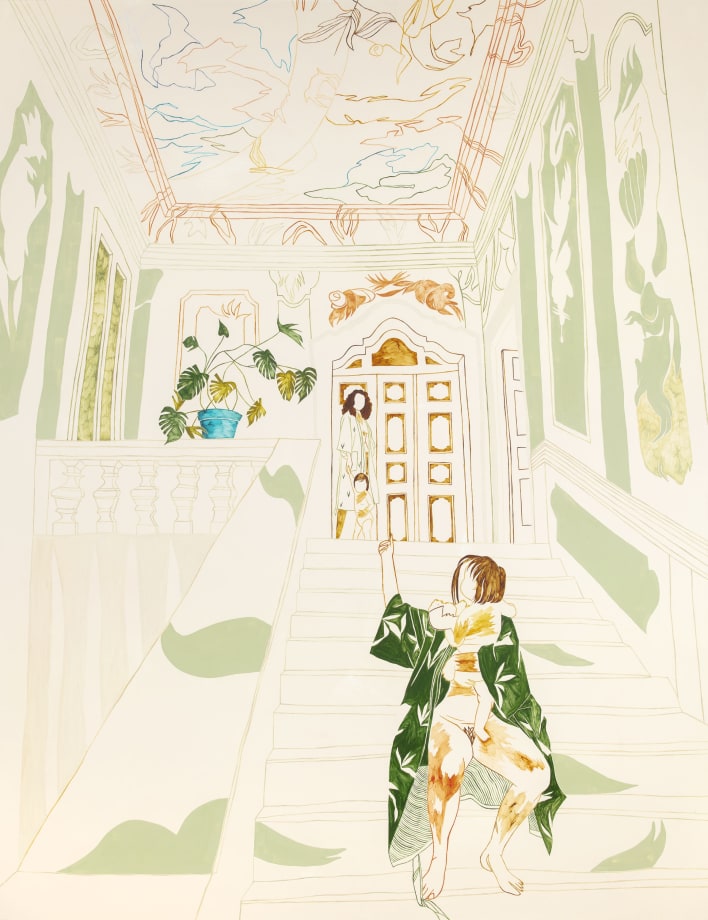Mariane Ibrahim presents Miranda Forrester's first solo exhibition in Chicago, titled Interiorities. The show is open February 2nd through April 6, 2024 and marks Forrester’s first show in Chicago and with the gallery.
Miranda Forrester paints instability. Her figures waver at the edge between presence and disappearance, between figuration and abstraction. They are liquid and incomplete bodies made from painterly outlines, tenuous gatherings of brushwork, and quick flashes of color. Like the queerness that they are informed by, they are painted in a language of fluidity, complexity, and mutability. Yet, despite the sense of almost frenetic precarity with the figures are rendered, Forrester’s scenes resonate with certain calm and quietude. The Black queer women painted here repose in comfort: they lie in each other’s arms, lean on doorways, and lounge on staircases. Taken together, Forrester’s paintings orient us towards a world in which Black queer people cannot be neatly defined and delimited, but instead revel in the sanctity of their quotidian being and desiring.
Forrester’s paintings are faceless, but they do not lack identities. In this suite of painting, five figures in the artist’s intimate orbit recur: her partner, her infant daughter, and three of her friends. For the artist and those in her close circle, the figures are instantly recognizable purely from their shape, outline, and affect. Yet at the same time, they are ambiguous enough that the viewer can imagine themselves slipping into their bodies and living in the scene. Stated otherwise, her figures simultaneously index precise individuality and slippery amorphousness; they mark the intimacy that is particular to Forrester’s relational life while also making room for the viewer to be touched by their own sentiments of identification and recognition.
To a large degree, these identifications are made possible by the daringness of Forrester’s material lexicon, particularly the material which she uses to ground her paintings. Instead of painting her worlds on conventional opaque materials like canvas or wood, the artist opts for polycarbonate, a clear, glass-like material often used in architectural construction. Given this unique material configuration, looking at Forrester’s paintings occasions looking through them.
The built environment of our own world bleeds into what’s happening in the imagined world of Forrester’s paintings; figures seem to step into our own dimension. The surfaces are windows, transparent openings which allow us to slither in and out of the paintings, which make us intimately linked with the life unfolding on the surface.
Not only do Forrester’s surfaces occasion a feeling of heightened closeness with the figures on/in them, but also, they invite us to sneak into the intimacies that work within and behind the painting: the frame and its backing boards, the gallery walls and the shadows that the paintings cast on them. The frames Forrester uses—which are made visible underneath the polycarbonate—resemble a conventional canvas stretcher. The idiosyncrasies of artisanship and labor are thus laid bare to the eye, spilling out from rather than being hidden underneath a canvas.
For Forrester, painting people is in all respects tied to placing people: the work answers her exigent need to visualize Black queer women in spaces where they can be the most expansive versions of themselves. The paintings on view at the gallery were created and are situated in a palazzo in Brescia, Italy, where the artist recently completed a residency. They are filled with the residue of Forrester’s engagement with the region’s aesthetic orientations: magisterial architecture, resplendent plant life, and allusions to Old Master paintings figure prominently. For example, in paintings like Moving Through and The Palazzo (both 2023), figures are ensconced in finely ornamented Baroque architecture. In Encased (2023), a mother and child are arranged in a closeness that recalls the composition of Renaissance Madonna and Child paintings.
Yet, various frictions rub against Forrester’s engagements with Italy’s art and architectural history. Her fascination with Italian paintings was cut by the glaring absence of Black figures and the white supremacist grammars of their rare appearance. The opulence surrounding her seethed with the disquieting realities of pillage and exploitation that subtended their making. And on the heels of her residency, the increasingly nationalist right-wing Italian government passed a set of laws constraining the freedoms of queer parents and families.
These tensions introduced vital questions that breathe underneath this set of paintings: What does it mean to picture Black queer love in spaces that have not loved Black queer people? How can such an undertaking complicate our notions of supposedly aspirational aesthetic luxury and beauty in a world where it is often shadowed by and the consequential to grotesque violence? Most importantly, what would it mean to think of beauty as proceeding first from the pictured relations of desire and care rather than from the palatial settings?
Forrester’s figures do not offer any clear-cut answers to these tangled questions, but instead, float in realms of open possibility. As they emerge into their unfinished states of being against transparent ground, they invite the viewer to envision Black queer women beyond the entrapments of being easily resolved.
Text by writer and critic Zoë Hopkins
